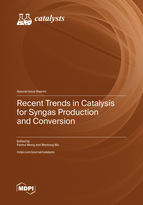A Dual-Bed Strategy for Direct Conversion of Syngas to Light Paraffins
Round 1
Reviewer 1 Report
It's a good study, with plenty of results. Nonetheless, english language must be thoroughly revised.
Author Response
Reviewer 1#
Comments: It's a good study, with plenty of results. Nonetheless, English language must be thoroughly revised.
Response: Thank you for the praise and valuable advice. We have checked the whole manuscript, and the revised words and expressions were marked as red in the revised manuscript.
Reviewer 2 Report
Potential Interest and Novelty: This paper by Wang et al reviews the potential of a dual-bed strategy for the direct conversion of syngas to valuable chemicals. This is of interest because the production of synthetic fuels and chemicals is of great importance nowadays and the pathway to achieving that is usually hindered by the use of appropriate materials. Although a lot of recent studies have been published in this area with impressive results ie ACS Energy Lett. 2022, 7, 4, 1462–1468 and Nat Commun 10, 1297 (2019), this paper seems quite focused and could potentially be of use for the researchers working in the area.
Structure and general presentation: Structure looks generally ok but the presentation could be improved. The colour annotations are not particularly consistent, same with the font size and the resolution of the graphs is not great.
Comments and recommendation: I would consider this paper for publication because I think the authors attempted to do a thorough experimental study, however there are some points that need to be addressed.
1. The authors should make more clear their contribution to the field by publishing this paper. No clear novelty is indicated.
2. The authors claim that the selectivity of C3H8 in hydrocarbons increased from 36.9% to 76.7% when the space velocity was changed. Why do they think this is the case?
3. Also how did they make sure that no transport phenomena affected this result?
4. Can the authors claim results with such accuracy when comparing 1.7% to 2.0%, or stating a methane selectivity of 0.8%?
5. Since this is a physical mixture, the different mechanisms of material deactivation and general change under reaction conditions would be expected to result in quick deterioration of the sample properties. Have the authors performed any post reaction characterisation of the samples?
Author Response
For the response to Reviewer 2, please see the attachment.
Author Response File: ![]() Author Response.docx
Author Response.docx
Reviewer 3 Report
Dear authors,
The manuscript is well written and justified but there are still some minor issues that have to be clarified. Please find below my comments in no specific order:
1. As reported in the literature, in the direct conversion of methanol to DME there are taken into account several reactions (apart of the main reaction for conversion of syngas to methanol, the CO2 hydrogenation to methanol as well as water gas shift reaction are still present). Can the authors justify the statement: “The direct conversion of syngas to light paraffins contains three reactions, i.e., the syngas conversion to methanol, the methanol to DME, and the DME conversion reaction.” (page 4, lines 136-137)?
2. The authors are stating that the direct conversion of syngas to DME was performed in a quartz tube fixed-bed reactor. As the operating pressure was about 2 MPa, was it experimentally possible? Please justify.
3. As CO2 is present in a high amount in the reaction mixture, its conversion should be discussed in the thermodynamic equilibrium section.
4. The composition of the effluent at the reactor outlet was determined by gas chromatography. How was the instrument calibrated in order to get quantitative results? As from the STP process is resulting a complex hydrocarbon mixture. Please mention in the manuscript.
5. The chemical transformation taking place in this reaction system should be presented.
6. Page 10, lines 337-338: in the relation calculating the CO equilibrium conversion are given both number of moles and molar flowrates. Please correct.
7. Page 5, lines 161-174: the authors are stating that “ The selectivity of MeOH gradually increased while the selectivity of DME gradually decreased, the reason was due to that a high GHSV reduced the residence time of methanol in the catalyst bed, which resulted in the methanol not converted in time.” Given that, from the thermodynamic point of view, the limiting step is the formation of methanol and not DME, probably in this case, at the temperature of 260 oC the alumina used as methanol to DME catalyst is not enough active to promote methanol conversion to ether. Could you please bring more arguments to your statement, eventually with literature references?
8. The reaction was carried out in a dual bed system. The authors are stating that in the first bed, the GHSV was 3000 mL/g/h and then, in the second bed the space velocity was varied from 16000 down to 6000 mL/g/h. Could you please bring more details how was this value obtained?
9. In Figure 6(b) what C3H8 selectivity in hydrocarbons is meaning? Is the amount of propane in the hydrocarbon mixture or something else? Please bring more details.
10. How was the pressure regulated in the dual bed system?
Author Response
For the response to Reviewer 3, please see the attachment.
Author Response File: ![]() Author Response.docx
Author Response.docx





